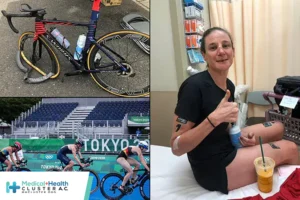La inteligencia artificial en medicina es el uso de modelos...
Leer más
Tocilizumab in patients admitted to hospital with COVID-19 (RECOVERY): a randomised, controlled, open-label, platform trial

Summary
Background
In this study, we aimed to evaluate the effects of tocilizumab in adult patients admitted to hospital with COVID-19 with both hypoxia and systemic inflammation.
Methods
This randomised, controlled, open-label, platform trial (Randomised Evaluation of COVID-19 Therapy [RECOVERY]), is assessing several possible treatments in patients hospitalised with COVID-19 in the UK. Those trial participants with hypoxia (oxygen saturation <92% on air or requiring oxygen therapy) and evidence of systemic inflammation (C-reactive protein ≥75 mg/L) were eligible for random assignment in a 1:1 ratio to usual standard of care alone versus usual standard of care plus tocilizumab at a dose of 400 mg–800 mg (depending on weight) given intravenously. A second dose could be given 12–24 h later if the patient’s condition had not improved. The primary outcome was 28-day mortality, assessed in the intention-to-treat population. The trial is registered with ISRCTN (50189673) and ClinicalTrials.gov (NCT04381936).
Findings
Between April 23, 2020, and Jan 24, 2021, 4116 adults of 21 550 patients enrolled into the RECOVERY trial were included in the assessment of tocilizumab, including 3385 (82%) patients receiving systemic corticosteroids. Overall, 621 (31%) of the 2022 patients allocated tocilizumab and 729 (35%) of the 2094 patients allocated to usual care died within 28 days (rate ratio 0·85; 95% CI 0·76–0·94; p=0·0028). Consistent results were seen in all prespecified subgroups of patients, including those receiving systemic corticosteroids. Patients allocated to tocilizumab were more likely to be discharged from hospital within 28 days (57% vs 50%; rate ratio 1·22; 1·12–1·33; p<0·0001). Among those not receiving invasive mechanical ventilation at baseline, patients allocated tocilizumab were less likely to reach the composite endpoint of invasive mechanical ventilation or death (35% vs 42%; risk ratio 0·84; 95% CI 0·77–0·92; p<0·0001).
Interpretation
In hospitalised COVID-19 patients with hypoxia and systemic inflammation, tocilizumab improved survival and other clinical outcomes. These benefits were seen regardless of the amount of respiratory support and were additional to the benefits of systemic corticosteroids.
Funding
Introduction
The majority of SARS-CoV-2 infections are either asymptomatic or result in only mild disease.
However, a substantial proportion of infected individuals develop a respiratory illness requiring hospital care, which can progress to critical illness with hypoxic respiratory failure requiring prolonged ventilatory support. Among COVID-19 patients admitted to UK hospitals in spring, 2020, the case fatality rate was over 26%, and was in excess of 37% in patients requiring invasive mechanical ventilation.
Hypoxic respiratory failure in patients with COVID-19 is associated with evidence of systemic inflammation, including release of pro-inflammatory cytokines, such as interleukin (IL)-1, IL-6, and tumour necrosis factor α, and elevated concentrations of D-dimer, ferritin, and C-reactive protein (CRP).
The host immune response is thought to play a key role in driving an acute inflammatory pneumonic process with diffuse alveolar damage, myeloid cell infiltrates, and microvascular thrombosis.
The beneficial effects of dexamethasone and other corticosteroids in COVID-19 patients with hypoxic lung damage suggest that other, more specific, immunomodulatory agents might provide additional improvements in clinical outcomes.
Tocilizumab is a recombinant humanised anti-IL-6 receptor monoclonal antibody that inhibits the binding of IL-6 to both membrane and soluble IL-6 receptors, blocking IL-6 signalling and reducing inflammation. Tocilizumab is licensed in the UK as an intravenous treatment for patients with rheumatoid arthritis and for people with chimeric antigen receptor T-cell-induced severe or life-threatening cytokine release syndrome. Randomised trials of tocilizumab in COVID-19 have so far shown mixed results for 28-day mortality: seven small trials reported no benefit and the somewhat larger REMAP-CAP trial reported a benefit in patients requiring organ support.
Here we report the results of a large randomised, controlled trial aimed at evaluating the effects of tocilizumab in adult patients hospitalised with severe COVID-19 characterised by hypoxia and substantial inflammation.
Research in context
Evidence before this study
We searched MEDLINE, Embase, and MedRxiv from inception up to March 5, 2021, for clinical trials or meta-analyses evaluating the effect of interleukin-6 inhibitor treatment on patients with COVID-19 using the search terms (“COVID-19” OR “COVID” OR “SARS-CoV-2” OR “2019-nCoV” OR “coronavirus”) AND (“tocilizumab” OR “sarilumab” OR “interleukin-6 inhibitor” or “IL-6 inhibitor”).
We identified eight relevant randomised trials that compared tocilizumab with usual care or placebo in hospitalised patients with COVID-19. All were assessed as at low risk of bias. Of these trials, only the REMAP-CAP trial in critically ill patients found a significant reduction in 28-day mortality with tocilizumab. A meta-analysis of these eight trials, which included a total of 439 deaths among 2379 patients showed no significant difference in 28-day mortality (death rate ratio 0·89, 95% CI 0·72–1·11).
Added value of this study
The Randomised Evaluation of COVID-19 Therapy (RECOVERY) trial is the largest randomised trial of the effect of tocilizumab in hospitalised patients with COVID-19. We found that in 4116 COVID-19 patients with hypoxia and a raised C-reactive protein, tocilizumab reduced 28-day mortality, increased the probability of discharge within 28 days, and, among patients who were not receiving invasive mechanical ventilation at randomisation, reduced the probability of progression to the composite outcome of invasive mechanical ventilation or death. The benefits were in addition to corticosteroids and consistent in all subgroups, regardless of the amount of respiratory support.
Implications of all the available evidence
Our finding shows that tocilizumab improves survival and other clinical outcomes in a broad group of patients hospitalised with COVID-19 and that these benefits are additional to those of corticosteroids.
Methods
Study design and participants
The Randomised Evaluation of COVID-19 Therapy (RECOVERY) trial is an investigator-initiated, individually randomised, controlled, open-label, platform trial to evaluate the effects of potential treatments in patients hospitalised with COVID-19. Details of the trial design and results for other possible treatments have been published previously.
The trial is being done in acute National Health Service hospitals in the UK, supported by the National Institute for Health Research Clinical Research Network (appendix pp 2–25). The trial is coordinated by the Nuffield Department of Population Health at University of Oxford (Oxford, UK), the trial sponsor. The trial is being done in accordance with the principles of the International Conference on Harmonisation–Good Clinical Practice guidelines and is approved by the UK Medicines and Healthcare products Regulatory Agency and the Cambridge East Research Ethics Committee. The protocol, statistical analysis plan, and additional information are available on the study website. This report is limited to adult patients. The randomised assessment of tocilizumab in children younger than 18 years is ongoing.
Patients admitted to hospital were eligible for the study if they had clinically suspected or laboratory confirmed SARS-CoV-2 infection and no medical history that might, in the opinion of the attending clinician, put the patient at substantial risk if they were to participate in the trial. Written informed consent was obtained from all patients, or their legal representative if they were too unwell or unable to provide consent.
Randomisation and masking
Data were collected at study entry using a web-based case report form that included demographics and major comorbidities (appendix p 32). All eligible and consenting patients received usual standard of care and underwent an initial (main) randomisation comprising up to three parts in a factorial design (appendix pp 29–30): part 1, no additional treatment versus either dexamethasone, lopinavir–ritonavir, hydroxychloroquine, azithromycin, or colchicine; part 2, no additional treatment versus either convalescent plasma or REGN-COV2 (a combination of two monoclonal antibodies directed against SARS-CoV-2 spike protein); and part 3, no additional treatment versus aspirin. Over time, treatment groups were added to and removed from the protocol (appendix pp 26–29), and not all treatments were available at every hospital. Similarly, not all treatments were suitable for some patients (eg, owing to comorbid conditions or concomitant medication). In any of these cases, randomisation was between fewer groups.
Up to 21 days after the main randomisation and regardless of treatment allocation, RECOVERY trial participants with clinical evidence of progressive COVID-19 (defined as oxygen saturation <92% on room air or receiving oxygen therapy, and CRP ≥75 mg/L) could be considered for randomisation to tocilizumab versus usual care alone. Baseline data collected for this randomisation included amount of respiratory support, markers of progressive COVID-19 (including most recent oxygen saturation, CRP, ferritin, and creatinine result before second randomisation), suitability for the study treatment, and treatment availability at the site (appendix pp 33–34). For some patients, tocilizumab was unavailable at the hospital at the time of enrolment or was considered by the managing physician to be either definitely indicated or definitely contraindicated. In such cases, the patients were not eligible for the tocilizumab randomisation. Patients with known hypersensitivity to tocilizumab, evidence of active tuberculosis infection or clear evidence of active bacterial, fungal, viral, or other infection (besides COVID-19) were not eligible for randomisation to tocilizumab.
Patients who were eligible for randomisation to tocilizumab were assigned to either usual standard of care or usual standard of care plus tocilizumab in a 1:1 ratio by means of web-based simple (unstratified) randomisation with allocation concealed until after randomisation. Allocated treatment was prescribed by the managing doctor. Roche Products (Welwyn Garden City, UK) supported the trial through provision of tocilizumab. Participants and local study staff were not masked to the allocated treatment. The steering committee, investigators, and all others involved in the trial were masked to the outcome data during the trial.
Procedures
Patients allocated to tocilizumab were to receive tocilizumab as a single intravenous infusion over 60 min. The dose of tocilizumab was established by bodyweight (800 mg if weight >90 kg; 600 mg if weight >65 and ≤90 kg; 400 mg if weight >40 and ≤65 kg; and 8 mg/kg if weight ≤40 kg). A second dose could be given 12–24 h later if, in the opinion of the attending clinician, the patient’s condition had not improved.
A single online follow-up form was completed when participants were discharged, had died, or at 28 days after the initial randomisation, whichever occurred earliest (appendix pp 35–41). Information was recorded on adherence to allocated study treatment, receipt of other COVID-19 treatments, duration of admission, receipt of respiratory or renal support, and vital status (including cause of death). In addition, routine health-care and registry data were obtained for the full follow-up period, including information on vital status (with date and cause of death), discharge from hospital, receipt of respiratory support, or renal replacement therapy.
Outcomes
Outcomes were assessed at 28 days after randomisation to tocilizumab versus usual care alone, with further analyses specified at 6 months. The primary outcome was all-cause mortality. Secondary outcomes were time to discharge from hospital, and, among patients not receiving invasive mechanical ventilation at randomisation, receipt of invasive mechanical ventilation (including extracorporeal membrane oxygenation) or death. Prespecified subsidiary clinical outcomes were use of non-invasive respiratory support (defined as high-flow nasal oxygen, continuous positive airway pressure, or non-invasive ventilation), time to successful cessation of invasive mechanical ventilation (defined as cessation of invasive mechanical ventilation within, and survival to, 28 days), and use of renal dialysis or haemofiltration. Prespecified safety outcomes included cause-specific mortality and major cardiac arrhythmia.
Information on suspected serious adverse reactions was collected in an expedited fashion to comply with regulatory requirements.
Statistical analysis
In accordance with the statistical analysis plan (version 2.1, appendix pp 93–117), an intention-to-treat comparison was done between patients who entered the randomised comparison of tocilizumab versus usual care. For the primary outcome of 28-day mortality, the log-rank observed minus expected statistic and its variance were used to test the null hypothesis of equal survival curves (ie, the log-rank test) and to calculate the one-step estimate of the average mortality rate ratio. We constructed Kaplan-Meier survival curves to display cumulative mortality over the 28-day period. We used the same method to analyse time to hospital discharge and successful cessation of invasive mechanical ventilation, with patients who died in hospital right-censored on day 29. For the prespecified composite secondary outcome of invasive mechanical ventilation or death within 28 days (among those not receiving invasive mechanical ventilation at randomisation) and the subsidiary clinical outcomes of receipt of ventilation and receipt of haemodialysis or haemofiltration, the precise dates were not available and so the risk ratio was estimated instead.
Prespecified analyses of the primary outcome were done in subgroups defined by six characteristics at the time of randomisation: age, sex, ethnicity, amount of respiratory support, days since symptom onset, and use of systemic corticosteroids (including dexamethasone). Observed effects within subgroup categories were compared by means of a χ2 test for heterogeneity or trend, in accordance with the prespecified analysis plan.
Estimates of rate and risk ratios are shown with 95% CIs. All p values are two-sided and are shown without adjustment for multiple testing. The full database is held by the study team which collected the data from study sites and did the analyses at the Nuffield Department of Population Health, University of Oxford (Oxford, UK).
Before commencement of the randomisation to tocilizumab versus usual care, the trial steering committee determined that if 28-day mortality in the usual care group was above 25% then recruitment of around 4000 patients to this comparison would provide 90% power at two-sided p=0·01 to detect a proportional reduction in 28-day mortality of one-fifth. Consequently, Roche Products provided sufficient treatment for 2000 patients to receive tocilizumab. The trial steering committee, masked to the results, closed recruitment to the tocilizumab comparison at the end of Jan 24, 2021, as over 4000 patients had been randomly assigned.
For the primary outcome of 28-day mortality, the results from RECOVERY were subsequently included in a meta-analysis of results from all previous randomised trials of tocilizumb versus usual care in patients with COVID-19. For each trial, we compared the observed number of deaths among patients allocated tocilizumab with the expected number if all patients were at equal risk (ie, we calculated the observed minus expected statistic [o–e], and its variance v). For RECOVERY, these were taken as the log-rank observed minus expected statistic and its variance but for other trials, where the exact timing of each death was not available, these were calculated from standard formulae for 2 × 2 contingency tables. We then combined trial results using the log of the mortality rate ratio calculated as the inverse-variance weighted average S/V with variance 1/V (and hence with 95% CI S/V ±1·96/√V), where S is the sum over all trials of (O–E) and V is the sum over all trials of v.
Analyses were done by means of SAS version 9.4 and R version 3.4. The trial is registered with ISRCTN (50189673) and ClinicalTrials.gov (NCT04381936).
Role of the funding source
Neither the funders of the study nor Roche Products had any role in study design, data collection, data analysis, data interpretation, or writing of the report. Roche Products supported the study through the supply of tocilizumab and reviewed the draft publication for factual accuracy relating to tocilizumab.
Results
Between April 23, 2020, and Jan 24, 2021, 4116 (19%) of 21 550 patients enrolled into the RECOVERY trial at one of the 131 sites in the UK participating in the tocilizumab comparison were eligible for random assignment. 2022 patients were randomly allocated to tocilizumab and 2094 were randomly allocated to usual care. The mean age of these participants was 63·6 years (SD 13·6). At randomisation, 562 (14%) of 4116 patients were receiving invasive mechanical ventilation, 1686 (41%) of 4116 were receiving non-invasive respiratory support (including high-flow nasal oxygen, continuous positive airway pressure, and non-invasive ventilation), and 1868 (45%) of 4116 were receiving no respiratory support other than simple oxygen therapy (nine of these patients were reportedly not receiving oxygen at randomisation; table 1). Median CRP was 143 (IQR 107–204) mg/L. 82% of patients were reported to be receiving corticosteroids at randomisation (and 97% of the patients enrolled since the announcement of the dexamethasone result from RECOVERY in June, 2020).




